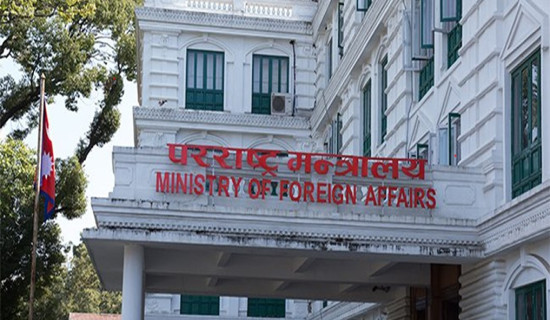- Monday, 1 December 2025
American economy, tariff and debt
Muhammad Zamir Assadi
“Sometimes you have to take medicine to fix something,” Donald Trump once quipped, dismissing worries about the collateral damage of his tariffs. Eight months into his second presidency, America is gulping down the medicine in heavy doses: sweeping tariffs, tax cuts, an avalanche of reforms and more than 200 executive orders—already surpassing his tally from his entire first term.
For a brief spell, the treatment seemed to work. After contracting by 0.5% in the first quarter of 2025, GDP grew by a buoyant 3.3% in the second. Yet behind the headline figure, the patient looks fragile. Jerome Powell, the chairman of the Federal Reserve, warned on September 23rd of “two-sided risks”: inflation that refuses to subside and an employment market that is faltering. On September 17th, as markets had anticipated, the Fed cut its benchmark rate by 25 basis points to a range of 4.00–4.25%—despite inflation still running above its 2% target.
Inflation is proving sticky. In August consumer prices were 2.9% higher than a year earlier, the sharpest rise since January. Fed officials now expect year-end inflation to hover around 3%. Powell was blunt: weakness in the labor market is outweighing concerns about stubborn inflation in the latest rate cut decisions.
Jobs are indeed scarce. The unemployment rate rose to 4.3% in August, the highest since 2021. The economy created only 22,000 jobs that month, far below expectations of 75,000. A revised dataset from the Bureau of Labor Statistics revealed that between April 2024 and March 2025 America added just 71,000 jobs a month on average—half the earlier announcements—and in some months, job growth actually turned negative. Wage growth, meanwhile, was running at less than half the pace required to keep unemployment stable.
Official data, always subject to suspicion, now leaves little room for optimism. A “daunting challenge” is cited by Powell in the Fed’s attempt to guide the U.S. economy clear of stagflation.
Anna Wong, chief economist at Bloomberg, bluntly concluded that the United States may have entered recession as far back as spring 2024.
An unsteady giant
The Fed’s September Summary of Commentary on Current Economic Conditions by Federal Reserve District (the “Beige Book”) recorded “little or no change” in economic activity across most districts.
Consumer spending, once America’s growth engine, is flat or declining. Wages trail prices, leaving households squeezed. Tariffs have compounded the pressure: the price of core goods excluding autos rose 0.5% in August alone. Apparel, electronics, car parts and groceries all saw disproportionate jumps. The 55-page Beige Book devoted much of its content to the impact of tariffs, noting that they have driven up production costs for businesses while adding to the burden on consumers. Goldman Sachs estimates that two-thirds of the cost of Trump’s trade war is falling squarely on American consumers.
Confidence is ebbing. The University of Michigan’s consumer-confidence index sank to 55.4 in September, far below forecasts. A PwC holiday survey suggested households plan to spend 5% less this season than last year—the first meaningful decline since the pandemic—with four-fifths expecting to cut back more broadly in the coming months, highlighting reasons including tariffs, prices, and increasing living costs.
Nor is industry faring better. America’s manufacturing sector shed 12,000 jobs in August and has lost 42,000 since April, according to a study by the Center for American Progress, a think-tank. The culprits: Trump’s tariff barrage, his restrictive stance on immigration, and the “Big and Beautiful Act”, which scales back tax credits for renewable energy firms. The result: higher costs, slower hiring and a wobbling industrial base.
That leaves both of America’s economic pillars—employment and consumer spending—under strain. Uncertainty has cast a shadow over the country’s economic outlook. The Fed’s Beige Book used the word “uncertainty” 80 times—up from just 11 a year ago. Goldman Sachs’s Jan Hatzius says the economy is “close to stalling”.
Globally, tariff barriers have triggered a forced restructuring of global supply chains and a contraction in trade. WTO data shows that due to the impact of U.S. tariffs, the growth forecast for global merchandise trade volume in 2025 has been revised down from 2.7% to 0.9%. Retaliatory and evasive actions by trading partners have further exacerbated the fragmentation of the global trading system. More profoundly, tariff policies have exposed the political risks associated with the dollar-based settlement system, forcing countries to reassess the reliability of the U.S. dollar as a trade medium.
More medicine, less cure
Trump has not been short of remedies: tariffs, experiments with stablecoins, sweeping tax reforms and even the nationalisation of firms such as Intel. His flurry of executive orders has dazzled supporters but done little to settle the patient. He has succeeded, however, in curing one ailment: the world’s long-standing confidence in American exceptionalism.
Earlier this month, Tavi Costa, Member and Macro Strategist of Crescat Capital noted a striking milestone: for the first time since 1996, gold accounted for a larger share of central-bank reserves than US Treasuries. Central banks have bought gold for 14 consecutive quarters, with annual purchases topping 1,000 tonnes in each of the past three years, double the average of the previous decade. A June survey by the World Gold Council found that 95% of central banks plan further purchases in the next 12 months, the highest proportion since the poll began.
Defined as a “significant milestone”, it indicates profound and long-term structural changes taking place in global reserve management, as Costa calls the shift “likely the beginning of one of the most significant global rebalancings we’ve experienced in recent history.”
According to Vishnu Varathan, chief economist and strategist at Mizuho Bank, investors are now focusing on deeper structural risks: mounting global debt, geopolitical turbulence, and the persistent erosion of the dollar’s value.
A new international currency order is in the making as alternatives to the dollar are gaining traction. Local-currency transactions between Malaysia and Indonesia have surged. Over 50 countries now use yuan, rupees or roubles for oil and defence trade under BRICS arrangements. India and the UAE are building links between their payment systems and central-bank digital currencies. China has launched cross-border QR code payment trials with Indonesia, bypassing the dollar entirely. By February 2025 the renminbi’s share of global payments had risen to 4.3%, from just 1.7% in 2018.
“Dollar weakness is now a portfolio reality, not just a forecast,” UBS said in its outlook report for the second half of 2025. Since the start of 2025, the dollar index has fallen 11.5% to below 97.
A boat too large to turn
Of all the challenges looming over America, none is more perilous—or less avoidable—than its towering debt. America’s liabilities now exceed $37trn, having evolved from a domestic issue into a "time bomb" threatening global financial stability, disrupting the global asset-pricing framework. Traditionally, rising Treasury yields would coincide with a stronger dollar; yet in early 2025, yields climbed even as the dollar weakened—a striking anomaly that reflects the market’s growing perception of U.S. assets as deeply entwined with policy risk.
Ray Dalio, the founder of Bridgewater, predicts a debt crisis within three years. Servicing costs already exceed $1trn annually. Some $9trn of debt is maturing and needs to be rolled over. That squeezes out other public spending: next year federal outlays will be around $7trn, while revenues are only $5trn, forcing the Treasury to issue $2trn in fresh debt, which will directly intensify the contradiction between supply and demand of market funds, push up the financing costs of the private sector, and squeeze the investment space of the real economy.
The Cato Institute warns the Fed may face an impossible choice: tolerate higher inflation to erode the debt, or hike rates sharply to defend the dollar, risking a fiscal crunch.
Behind the macro numbers lies a troubling social picture. Credit-card debt has soared to a record $1.32trn, with utilisation rates above 30%, a red-flag threshold. Inequality is deepening: the wealthiest 0.1% of households now control 13.8% of national wealth, a historic high, while the bottom half own just 2.5%.
The rising cost of living, the decline in corporate profits and the disruption of supply chains are eroding the very foundation of the US economy.
“It is also increasingly being realized that the United States' role as the world's biggest consumer of manufactured goods and greatest producer of debt assets to finance its over-consumption is unsustainable, so assuming that one can sell and lend to the U.S. and get paid back with hard (i.e. not devalued) dollars on their U.S. debt holdings is naive thinking,” Ray Dalio wrote, arguing “whatever happens with tariffs, these problems won't go away, and that radically reduced interdependencies with the U.S. is a reality that has to be planned for.”















